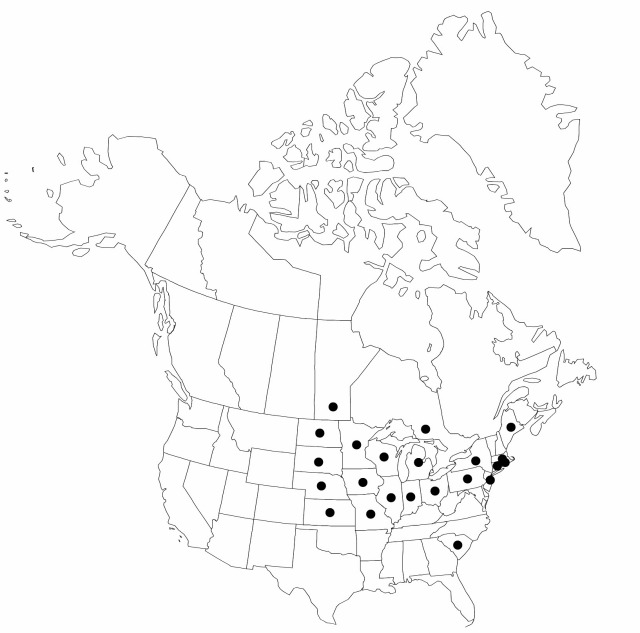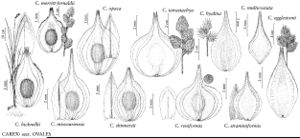Carex bicknellii
in N. L. Britton and A. Brown, Ill. Fl. N. U.S. 1: 360. 1896.
Plants cespitose with fewer than 25 culms per clump; rhizomes appearing elongate only in old clumps. Culms (35–)40–110 cm; vegetative culms few, inconspicuous, with 6–8 leaves, not strikingly 3-ranked. Leaves: sheaths adaxially white-hyaline, summits concave or truncate, prolonged beyond collar to 2.5 mm, papillose at least near apex; distal ligules 1–5 mm; blades 3–4 per fertile culm, 2.5–25 cm × 2–5 mm, usually adaxially papillose. Inflorescences open, pale brown, 0.24–0.62 cm × 8–15 mm; proximal internode 5–17 mm; 2d internode 3–10 mm; proximal bracts scalelike, with bristle tips shorter than inflorescences. Spikes 3–6(–8), distant, distinct, ovoid to clavate, 7–21 × 5.5–12 mm, base rounded to long tapered, apex rounded. Pistillate scales reddish brown with green midstripe, lance-ovate to ovate, 3.1–5.4 mm, 1.9–3.2 times as long as wide, (1–)1.4–2.3 mm shorter than perigynia, narrower than perignyia, apex obtuse to acute. Anthers (2.4–)2.8–4.2 mm. Staminate scales obtuse. Perigynia 15–80 in larger spikes, ascending or ascending-spreading, green to pale whitish green with reddish brown margin, conspicuously 8–12-veined abaxially, 4–8-veined adaxially, broadly elliptic to nearly orbiculate, (4.5–)5.1–6.7(–7.1) × (2.4–)2.8–4.2 mm, 0.5–0.7 mm thick, membranaceous with brown achene visible through hyaline adaxial face, margin flat, including wing 0.8–1.2 mm wide, often erose, scalloped, or with an irregular tooth, smooth; beak pale brown at tip, flat, ciliate-serrulate, abaxial suture inconspicuous, distance from beak tip to achene 2.4–3.7 mm. Achenes elliptic to oblong, 1.6–2.2 × 1.1–1.6 mm, 0.5 mm thick. 2n = 76, 78.
Phenology: Fruiting spring.
Habitat: Dry to mesic prairies, open woodlands, rock or sand barrens
Elevation: 50–400 m
Distribution

Man., Ont., Conn., Maine, Mass., Ill., Ind., Iowa, Kans., Mich., Minn., Mo., Nebr., N.J., N.Y., N.Dak., Ohio, Pa., R.I., S.C., S.Dak., Wis.
Discussion
Selected References
None.
